ESAB 161 STL THERMAL ARC® Inverter Arc Welder Manuel utilisateur
- Catégorie
- Système de soudage
- Taper
- Manuel utilisateur
Ce manuel convient également à

Art# A-09194_AB
50
60
Hz
Art#: A-09783
THERMAL ARC
®
INVERTER ARC WELDER
161 STL
Operating Manual
Revision: AA Issue Date: October 14, 2010 Manual No.: 0-5147
Operating Features:

WE APPRECIATE YOUR BUSINESS!
Congratulations on your new Thermal Arc product. We are proud
to have you as our customer and will strive to provide you with
the best service and reliability in the industry. This product
is backed by our extensive warranty and world-wide service
network. To locate your nearest distributor or service agency call
1-800-462-2782, or visit us on the web at www.Thermalarc.com.
This Operating Manual has been designed to instruct you on the
correct use and operation of your Thermal Arc product. Your
satisfaction with this product and its safe operation is our ultimate
concern. Therefore please take the time to read the entire manual,
especially the Safety Precautions. They will help you to avoid potential
hazards that may exist when working with this product.
YOU ARE IN GOOD COMPANY!
The Brand of Choice for Contractors and Fabricators Worldwide.
Thermal Arc is a Global Brand of Arc Welding Products for Thermadyne
Industries Inc. We manufacture and supply to major welding industry
sectors worldwide including; Manufacturing, Construction, Mining,
Automotive, Aerospace, Engineering, Rural and DIY/Hobbyist.
We distinguish ourselves from our competition through market-
leading, dependable products that have stood the test of time. We
pride ourselves on technical innovation, competitive prices, excellent
delivery, superior customer service and technical support, together
with excellence in sales and marketing expertise.
Above all, we are committed to develop technologically advanced
products to achieve a safer working environment within the welding
industry.

!
WARNINGS
Read and understand this entire Manual and your employer’s safety practices before installing,
operating, or servicing the equipment.
While the information contained in this Manual represents the Manufacturer’s best judgment, the
Manufacturer assumes no liability for its use.
Operating Manual Number 0-5147 for:
Thermal Arc 161 STL Power Source Arc Welder Part No. W1003700
Thermal Arc 161 STL System with Stick/TIG Kit & Case Part No. W1003701
Published by:
Thermadyne Industries Inc.
82 Benning Street
West Lebanon, New Hampshire, USA 03784
(603) 298-5711
www.thermalarc.com
Copyright
©
2010 by
Thermadyne Industries Inc.
®
All rights reserved.
Reproduction of this work, in whole or in part, without written permission of the publisher is prohibited.
The publisher does not assume and hereby disclaims any liability to any party for any loss or damage
caused by any error or omission in this Manual, whether such error results from negligence, accident, or
any other cause.
Publication Date: October 14, 2010
Record the following information for Warranty purposes:
Where Purchased: ____________________________________
Purchase Date: ____________________________________
Equipment Serial #: ____________________________________
i

TABLE OF CONTENTS
SECTION 1:SAFETY INSTRUCTIONS AND WARNINGS ................................................ 1-1
1.01 Arc Welding Hazards ....................................................................................... 1-1
1.02 General Safety Information for Victor CS Regulator .......................................... 1-4
1.03 Principal Safety Standards .............................................................................. 1-5
1.04 Symbol Chart .................................................................................................. 1-6
1.05 Precautions De Securite En Soudage A L’arc .................................................. 1-7
1.06 Dangers relatifs au soudage à l’arc ................................................................. 1-7
1.07 Informations Générales de Sécurité .............................................................. 1-10
1.08 Principales Normes De Securite ................................................................... 1-12
1.09 Graphique de Symbole .................................................................................. 1-13
SECTION 2:INTRODUCTION ............................................................................... 2-1
2.01 How to Use This Manual ................................................................................. 2-1
2.02 Equipment Identification ................................................................................. 2-1
2.03 Receipt of Equipment ...................................................................................... 2-1
2.04 Description ..................................................................................................... 2-1
2.05 Transportation Methods .................................................................................. 2-1
2.06 Duty Cycle ....................................................................................................... 2-1
2.07 Specifications ................................................................................................. 2-2
SECTION 3:INSTALLATION ................................................................................ 3-1
3.01 Environment ................................................................................................... 3-1
3.02 Location .......................................................................................................... 3-1
3.03 Electrical Input Connections ........................................................................... 3-1
3.04 Electromagnetic Compatibility ........................................................................ 3-4
3.05 Setup for Welding ........................................................................................... 3-5
3.06 STICK (SMAW) Setup ..................................................................................... 3-6
3.07 LIFT TIG (GTAW) Setup................................................................................... 3-7
3.08 Victor Regulator .............................................................................................. 3-8
3.09 Leak Testing the System ............................................................................... 3-10
3.10 When You Finish Using the Regulator ........................................................... 3-10
3.11 Storage of the Regulator ............................................................................... 3-11

TABLE OF CONTENTS
SECTION 4:OPERATION .................................................................................... 4-1
4.01 Front Panel ..................................................................................................... 4-1
4.02 Welding Current Control Explanation .............................................................. 4-3
4.03 STICK (SMAW) Electrode Polarity................................................................... 4-4
4.04 Effects of Stick Welding Various Materials ...................................................... 4-4
4.05 GTAW Electrode Polarity ................................................................................. 4-5
4.06 Guide for Selecting Filler Wire ........................................................................ 4-5
4.07 Tungsten Electrode Current Ranges ................................................................ 4-5
4.08 Shielding Gas Selection .................................................................................. 4-5
4.09 Tungsten Electrode Types ............................................................................... 4-5
4.10 TIG Welding Parameters for Steel ................................................................... 4-6
4.11 Arc Welding Practice ....................................................................................... 4-6
4.12 Welding Position ............................................................................................. 4-7
4.13 Joint Preparations ........................................................................................... 4-8
4.14 Arc Welding Technique ................................................................................... 4-9
4.15 The Welder ...................................................................................................... 4-9
4.16 Striking the Arc ............................................................................................... 4-9
4.17 Arc Length ...................................................................................................... 4-9
4.18 Rate of Travel .................................................................................................. 4-9
4.19 Making Welded Joints ................................................................................... 4-10
4.20 Distortion ...................................................................................................... 4-12
4.21 The Cause of Distortion ................................................................................ 4-12
4.22 Overcoming Distortion Effects ...................................................................... 4-13
SECTION 5:SERVICE ....................................................................................... 5-1
5.01 Maintenance and Inspection ........................................................................... 5-1
5.02 STICK (SMAW) Welding Problems ................................................................ 5-2
5.03 TIG Welding Problems ................................................................................... 5-3
5.04 Power Source Problems ................................................................................ 5-4
APPENDIX 1: REPLACEMENT PARTS .................................................................... A-1
APPENDIX 2: OPTIONS AND ACCESSORIES ............................................................ A-2
APPENDIX 3: SYSTEM SCHEMATIC ..................................................................... A-3
LIMITED WARRANTY
WARRANTY SCHEDULE

Art# A-09782
Thermal Arc 161STL Stick System
Part Number W1003701
• Thermal Arc 161STL power supply in toolbox
• 17 TIG torch, 12.5ft (3.8m) with accessory kit
• Tweco electrode holder, 13ft (4m) lead
• Tweco ground (work) clamp, 10ft (3.1m) lead
• 4 GP 1/8" (3.2mm) dia stick electrodes
• 230V to 115V adapter
• Victor Cutskill 2G Gas Regulator
• Quick set-up DVD
• Operating manual

SAFETY INSTRUCTIONS THERMAL ARC 161 STL
Manual 0-5147 1-1 Safety InstructionsSafety Instructions
1.01 Arc Welding Hazards
WARNING
ELECTRIC SHOCK can kill.
Touching live electrical parts can cause fatal shocks or
severe burns. The electrode and work circuit is electri-
cally live whenever the output is on. The input power
circuit and machine internal circuits are also live when
power is on. In semi-automatic or automatic wire weld-
ing, the wire, wire reel, drive roll housing, and all metal
parts touching the welding wire are electrically live.
Incorrectly installed or improperly grounded equipment
is a hazard.
1. Do not touch live electrical parts.
2. Wear dry, hole-free insulating gloves and body protection.
3. Insulate yourself from work and ground using dry insulating mats
or covers.
4. Disconnect input power or stop engine before installing or
servicing this equipment. Lock input power disconnect switch
open, or remove line fuses so power cannot be turned on
accidentally.
5. Properly install and ground this equipment according to its Owner’s
Manual and national, state, and local codes.
6. Turn off all equipment when not in use. Disconnect power to
equipment if it will be left unattended or out of service.
7. Use fully insulated electrode holders. Never dip holder in water to
cool it or lay it down on the ground or the work surface. Do not
touch holders connected to two welding machines at the same
time or touch other people with the holder or electrode.
8. Do not use worn, damaged, undersized, or poorly spliced
cables.
9. Do not wrap cables around your body.
10. Ground the workpiece to a good electrical (earth) ground.
11. Do not touch electrode while in contact with the work (ground)
circuit.
12. Use only well-maintained equipment. Repair or replace damaged
parts at once.
13. In confined spaces or damp locations, do not use a welder with AC
output unless it is equipped with a voltage reducer. Use equipment
with DC output.
14. Wear a safety harness to prevent falling if working above floor
level.
15. Keep all panels and covers securely in place.
WARNING
ARC RAYS can burn eyes and skin; NOISE can damage
hearing. Arc rays from the welding process produce
intense heat and strong ultraviolet rays that can burn
eyes and skin. Noise from some processes can damage
hearing.
1. Wear a welding helmet fitted with a proper shade of filter (see
ANSI Z49.1 listed in Safety Standards) to protect your face and
eyes when welding or watching.
2. Wear approved safety glasses. Side shields recommended.
3. Use protective screens or barriers to protect others from flash and
glare; warn others not to watch the arc.
4. Wear protective clothing made from durable, flame-resistant
material (wool and leather) and foot protection.
5. Use approved ear plugs or ear muffs if noise level is high.
SECTION 1:
SAFETY INSTRUCTIONS AND WARNINGS
!
WARNING
PROTECT YOURSELF AND OTHERS FROM POSSIBLE SERIOUS INJURY OR DEATH. KEEP CHILDREN AWAY. PACEMAKER WEARERS KEEP
AWAY UNTIL CONSULTING YOUR DOCTOR. DO NOT LOSE THESE INSTRUCTIONS. READ OPERATING/INSTRUCTION MANUAL BEFORE
INSTALLING, OPERATING OR SERVICING THIS EQUIPMENT.
Welding products and welding processes can cause serious injury or death, or damage to other equipment or property, if the operator does not
strictly observe all safety rules and take precautionary actions.
Safe practices have developed from past experience in the use of welding and cutting. These practices must be learned through study and
training before using this equipment. Some of these practices apply to equipment connected to power lines; other practices apply to engine
driven equipment. Anyone not having extensive training in welding and cutting practices should not attempt to weld.
Safe practices are outlined in the American National Standard Z49.1 entitled: SAFETY IN WELDING AND CUTTING. This publication and other
guides to what you should learn before operating this equipment are listed at the end of these safety precautions. HAVE ALL INSTALLATION,
OPERATION, MAINTENANCE, AND REPAIR WORK PERFORMED ONLY BY QUALIFIED PEOPLE.

THERMAL ARC 161 STL SAFETY INSTRUCTIONS
Safety Instructions 1-2 1-2 Manual 0-5147Manual 0-5147
WARNING
FUMES AND GASES can be hazardous to your health.
Welding produces fumes and gases. Breathing these
fumes and gases can be hazardous to your health.
1. Keep your head out of the fumes. Do not breathe the fumes.
2. If inside, ventilate the area and/or use exhaust at the arc to remove
welding fumes and gases.
3. If ventilation is poor, use an approved air-supplied respirator.
4. Read the Material Safety Data Sheets (MSDSs) and the
manufacturer’s instruction for metals, consumables, coatings,
and cleaners.
5. Work in a confined space only if it is well ventilated, or while
wearing an air-supplied respirator. Shielding gases used for
welding can displace air causing injury or death. Be sure the
breathing air is safe.
6. Do not weld in locations near degreasing, cleaning, or spraying
operations. The heat and rays of the arc can react with vapors to
form highly toxic and irritating gases.
7. Do not weld on coated metals, such as galvanized, lead, or
cadmium plated steel, unless the coating is removed from the weld
area, the area is well ventilated, and if necessary, while wearing
an air-supplied respirator. The coatings and any metals containing
these elements can give off toxic fumes if welded.
WARNING
WELDING can cause fire or explosion.
Sparks and spatter fly off from the welding arc. The flying
sparks and hot metal, weld spatter, hot workpiece, and
hot equipment can cause fires and burns. Accidental
contact of electrode or welding wire to metal objects
can cause sparks, overheating, or fire.
1. Protect yourself and others from flying sparks and hot metal.
2. Do not weld where flying sparks can strike flammable material.
3. Remove all flammables within 35 ft (10.7 m) of the welding arc.
If this is not possible, tightly cover them with approved covers.
4. Be alert that welding sparks and hot materials from welding can
easily go through small cracks and openings to adjacent areas.
5. Watch for fire, and keep a fire extinguisher nearby.
6. Be aware that welding on a ceiling, floor, bulkhead, or partition
can cause fire on the hidden side.
7. Do not weld on closed containers such as tanks or drums.
8. Connect work cable to the work as close to the welding area as
practical to prevent welding current from traveling long, possibly
unknown paths and causing electric shock and fire hazards.
9. Do not use welder to thaw frozen pipes.
10. Remove stick electrode from holder or cut off welding wire at
contact tip when not in use.
Welding or Cutting
Operation
Electrode Siz
e
Metal Thickness
or Weldin
g
Current
Filter
Shade
No.
Welding or Cutting
Operation
Electrode Siz
e
Metal Thickness
or Weldin
g
Filter
Shade
No.
Torch soldering 2
Gas metal-arc
welding (MIG)
Torch brazing 3 or 4 Non-ferrous base metal All 11
Oxygen Cutting
Non-ferrous base metal All 12
Light Under 1 in., 25 mm 3 or 4 Gas tungsten arc welding All 12
Medium 1 to 6 in., 25-150 mm 4 or 5 (TIG) All 12
Heavy Over 6 in., 150 mm 5 or 6 Atomic hydrogen welding All 12
Gas welding
Carbon arc welding All 12
Light Under 1/8 in., 3 mm 4 or 5 Plasma arc welding
Medium 1/8 to 1/2 in., 3-12 mm 5 or 6
Carbon arc air gouging
Heavy Over 1/2 in., 12 mm 6 or 8 Light 12
Shielded metal-arc
welding
(stick) electrodes
Under 5/32 in., 4 mm 10 Heavy 14
5/32 to 1/4 in.,
4 to 6.4 mm
12
Plasma arc cutting
Over 1/4 in., 6.4 mm 14 Light Under 300 Amp 9
Medium 300 to 400 Amp 12
Heavy Over 400 Amp 14
Eye protection filter shade selector for welding or cutting
(goggles or helmet), from AWS A6.2-73.

SAFETY INSTRUCTIONS THERMAL ARC 161 STL
Manual 0-5147 1-3 Safety InstructionsSafety Instructions
WARNING
FLYING SPARKS AND HOT METAL can cause injury.
Chipping and grinding cause flying metal. As welds cool,
they can throw off slag.
1. Wear approved face shield or safety goggles. Side shields
recommended.
2. Wear proper body protection to protect skin.
WARNING
CYLINDERS can explode if damaged.
Shielding gas cylinders contain gas under high pressure.
If damaged, a cylinder can explode. Since gas cylinders
are normally part of the welding process, be sure to treat
them carefully.
1. Protect compressed gas cylinders from excessive heat, mechanical
shocks, and arcs.
2. Install and secure cylinders in an upright position by chaining
them to a stationary support or equipment cylinder rack to prevent
falling or tipping.
3. Keep cylinders away from any welding or other electrical
circuits.
4. Never allow a welding electrode to touch any cylinder.
5. Use only correct shielding gas cylinders, regulators, hoses, and
fittings designed for the specific application; maintain them and
associated parts in good condition.
6. Turn face away from valve outlet when opening cylinder valve.
7. Keep protective cap in place over valve except when cylinder is in
use or connected for use.
8. Read and follow instructions on compressed gas cylinders,
associated equipment, and CGA publication P-1 listed in Safety
Standards.
!
WARNING
Engines can be dangerous.
WARNING
ENGINE EXHAUST GASES can kill.
Engines produce harmful exhaust gases.
1. Use equipment outside in open, well-ventilated areas.
2. If used in a closed area, vent engine exhaust outside and away
from any building air intakes.
WARNING
ENGINE FUEL can cause fire or explosion.
Engine fuel is highly flammable.
1. Stop engine before checking or adding fuel.
2. Do not add fuel while smoking or if unit is near any sparks or open
flames.
3. Allow engine to cool before fueling. If possible, check and add fuel
to cold engine before beginning job.
4. Do not overfill tank — allow room for fuel to expand.
5. Do not spill fuel. If fuel is spilled, clean up before starting
engine.
WARNING
MOVING PARTS can cause injury.
Moving parts, such as fans, rotors, and belts can cut fingers and hands
and catch loose clothing.
1. Keep all doors, panels, covers, and guards closed and
securely in place.
2. Stop engine before installing or connecting unit.
3. Have only qualified people remove guards or covers for
maintenance and troubleshooting as necessary.
4. To prevent accidental starting during servicing, disconnect
negative (-) battery cable from battery.
5. Keep hands, hair, loose clothing, and tools away from moving
parts.
6. Reinstall panels or guards and close doors when servicing
is finished and before starting engine.
WARNING
SPARKS can cause BATTERY GASES TO EXPLODE;
BATTERY ACID can burn eyes and skin.
Batteries contain acid and generate explosive gases.
1. Always wear a face shield when working on a battery.
2. Stop engine before disconnecting or connecting battery cables.
3. Do not allow tools to cause sparks when working on a battery.
4. Do not use welder to charge batteries or jump start vehicles.
5. Observe correct polarity (+ and –) on batteries.

THERMAL ARC 161 STL SAFETY INSTRUCTIONS
Safety Instructions 1-4 1-4 Manual 0-5147Manual 0-5147
WARNING
STEAM AND PRESSURIZED HOT COOLANT can burn
face, eyes, and skin.
The coolant in the radiator can be very hot and under
pressure.
1. Do not remove radiator cap when engine is hot. Allow engine to
cool.
2. Wear gloves and put a rag over cap area when removing cap.
3. Allow pressure to escape before completely removing cap.
LEAD WARNING
This product contains chemicals, including lead, or
otherwise produces chemicals known to the State of
California to cause cancer, birth defects and other re-
productive harm. Wash hands after handling. (California
Health & Safety Code § 25249.5 et seq.)
NOTE
Considerations About Welding And The Effects of Low
Frequency Electric and Magnetic Fields
The following is a quotation from the General Conclusions Section of
the U.S. Congress, Office of Technology Assessment, Biological Effects
of Power Frequency Electric & Magnetic Fields - Background Paper,
OTA-BP-E-63 (Washington, DC: U.S. Government Printing Office, May
1989): “...there is now a very large volume of scientific findings based
on experiments at the cellular level and from studies with animals
and people which clearly establish that low frequency magnetic fields
interact with, and produce changes in, biological systems. While most
of this work is of very high quality, the results are complex. Current
scientific understanding does not yet allow us to interpret the evidence
in a single coherent framework. Even more frustrating, it does not
yet allow us to draw definite conclusions about questions of possible
risk or to offer clear science-based advice on strategies to minimize
or avoid potential risks.”
To reduce magnetic fields in the workplace, use the following
procedures.
1. Keep cables close together by twisting or taping them.
2. Arrange cables to one side and away from the operator.
3. Do not coil or drape cable around the body.
4. Keep welding power source and cables as far away from body
as practical.
!
ABOUT PACEMAKERS:
The above procedures are among those also normally
recommended for pacemaker wearers. Consult your
doctor for complete information.
1.02 General Safety Information for Victor
CS Regulator
A Fire Prevention
Welding and cutting operations use fire or combustion as a basic
tool. The process is very useful when properly controlled. However,
it can be extremely destructive if not performed correctly in the proper
environment.
1. The work area must have a fireproof floor.
2. Work benches or tables used during welding or cutting
operations must have fireproof tops.
3. Use heat resistant shields or other approved material to pro-
tect nearby walls or unprotected flooring from sparks and hot
metal.
4. Keep an approved fire extinguisher of the proper size and
type in the work area. Inspect it regularly to ensure that it
is in proper working order. Know how to use the fire extin-
guisher.
5. Move combustible materials away from the work site. If you
can not move them, protect them with fireproof covers.
!
WARNING
NEVER perform welding, heating, or cutting operations
on a container that has held toxic, combustible or
flammable liquids, or vapors. NEVER perform welding,
heating, or cutting operations in an area containing com-
bustible vapors, flammable liquids, or explosive dust.
B Housekeeping
!
WARNING
NEVER allow oxygen to contact grease, oil, or other
flammable substances. Although oxygen by itself will
not burn, these substances become highly explosive.
They can ignite and burn violently in the presence of
oxygen.
Keep ALL apparatus clean and free of grease, oil and other flammable
substances.
C Ventilation
!
WARNING
Adequately ventilate welding, heating, and cutting work
areas to prevent accumulation of explosive or toxic
concentrations of gases. Certain combinations of metals,
coatings, and gases generate toxic fumes. Use respira-
tory protection equipment in these circumstances. When
welding/brazing, read and understand the Material Safety
Data Sheet for the welding/brazing alloy.

SAFETY INSTRUCTIONS THERMAL ARC 161 STL
Manual 0-5147 1-5 Safety InstructionsSafety Instructions
D Personal Protection
Gas flames produce infrared radiation which may have a harmful effect
on the skin and especially on the eyes. Select goggles or a mask with
tempered lenses, shaded 4 or darker, to protect your eyes from injury
and provide good visibility of the work.
Always wear protective gloves and flame-resistant clothing to protect skin
and clothing from sparks and slag. Keep collars, sleeves, and pockets
buttoned. DO NOT roll up sleeves or cuff pants.
When working in a non-welding or cutting environment, always wear
suitable eye protection or face shield.
!
WARNING
Practice the following safety and operation precautions
EVERY TIME you use pressure regulation equipment.
Deviation from the following safety and operation
instructions can result in fire, explosion, damage to
equipment, or injury to the operator.
E Compressed Gas Cylinders
The Department of Transportation (DOT) approves the design and
manufacture of cylinders that contain gases used for welding or cut-
ting operations.
1. Place the cylinder (Figure 1-1) where you will use it. Keep
the cylinder in a vertical position. Secure it to a cart, wall, work
bench, post, etc.
Figure 1-1: Gas Cylinders
!
WARNING
Cylinders are highly pressurized. Handle with care.
Serious accidents can result from improper handling
or misuse of compressed gas cylinders DO NOT drop
the cylinder, knock it over, or expose it to excessive
heat, flames or sparks. DO NOT strike it against other
cylinders. Contact your gas supplier or refer to CGA P-
1 “Safe Handling of Compressed Gases in Containers”
publication.
NOTE
CGA P-1 publication is available by writing the Com-
pressed Gas Association, 4221 Walney Road, 5th Floor,
Chantilly,VA 20151-2923
2. Place the valve protection cap on the cylinder whenever
moving it, placing it in storage, or not using it. Never drag or
roll cylinders in any way. Use a suitable hand truck to move
cylinders.
3. Store empty cylinders away from full cylinders. Mark them
“EMPTY” and close the cylinder valve.
4. NEVER use compressed gas cylinders without a pressure
reducing regulator attached to the cylinder valve.
5. Inspect the cylinder valve for oil, grease, and damaged
parts.
!
WARNING
DO NOT use the cylinder if you find oil, grease or dam-
aged parts. Inform your gas supplier of this condition
immediately.
6. Momentarily open and close (called “cracking”) the cylinder
valve to dislodge any dust or dirt that may be present in the
valve.
CAUTION
Open the cylinder valve slightly. If you open the valve
too much, the cylinder could tip over. When cracking
the cylinder valve, DO NOT stand directly in front of
the cylinder valve. Always perform cracking in a well
ventilated area. If an acetylene cylinder sprays a mist
when cracked, let it stand for 15 minutes. Then, try to
crack the cylinder valve again. If this problem persists,
contact your gas supplier.
1.03 Principal Safety Standards
Safety in Welding and Cutting, ANSI Standard Z49.1, from American
Welding Society, 550 N.W. LeJeune Rd., Miami, FL 33126.
Safety and Health Standards, OSHA 29 CFR 1910, from Superintendent
of Documents, U.S. Government Printing Office, Washington, D.C.
20402.
Recommended Safe Practices for the Preparation for Welding and
Cutting of Containers That Have Held Hazardous Substances, American
Welding Society Standard AWS F4.1, from American Welding Society,
550 N.W. LeJeune Rd., Miami, FL 33126.
National Electrical Code, NFPA Standard 70, from National Fire
Protection Association, Batterymarch Park, Quincy, MA 02269.
Safe Handling of Compressed Gases in Cylinders, CGA Pamphlet P-1,
from Compressed Gas Association, 1235 Jefferson Davis Highway,
Suite 501, Arlington, VA 22202.
Code for Safety in Welding and Cutting, CSA Standard W117.2, from
Canadian Standards Association, Standards Sales, 178 Rexdale
Boulevard, Rexdale, Ontario, Canada M9W 1R3.
Safe Practices for Occupation and Educational Eye and Face Protection,
ANSI Standard Z87.1, from American National Standards Institute,
1430 Broadway, New York, NY 10018.
Cutting and Welding Processes, NFPA Standard 51B, from National Fire
Protection Association, Batterymarch Park, Quincy, MA 02269.

THERMAL ARC 161 STL SAFETY INSTRUCTIONS
Safety Instructions 1-6 1-6 Manual 0-5147Manual 0-5147
1.04 Symbol Chart
Note that only some of these symbols will appear on your model.
Gas Tungsten Arc
Welding (GTAW)
Air Carbon Arc
Cutting (CAC-A)
Constant Current
Constant Voltage
Or Constant Potential
High Temperature
Fault Indication
Arc Force
Touch Start (GTAW)
Variable Inductance
Voltage Input
Single Phase
Three Phase
Three Phase Static
Frequency Converter-
Transformer-Rectifier
Dangerous Voltage
Off
On
Panel/Local
Shielded Metal
Arc Welding (SMAW)
Gas Metal Arc
Welding (GMAW)
Increase/Decrease
Circuit Breaker
AC Auxiliary Power
Remote
Duty Cycle
Percentage
Amperage
Voltage
Hertz (cycles/sec)
Frequency
Negative
Positive
Direct Current (DC)
Protective Earth
(Ground)
Line
Line Connection
Auxiliary Power
Receptacle Rating-
Auxiliary Power
Art # A-04130
115V 15A
t
t1
t2
%
X
IPM
MPM
t
V
Fuse
Wire Feed Function
Wire Feed Towards
Workpiece With
Output Voltage Off.
Preflow Time
Postflow Time
Spot Time
Spot Weld Mode
Continuous Weld
Mode
Press to initiate wirefeed and
welding, release to stop.
Purging Of Gas
Inches Per Minute
Meters Per Minute
Welding Gun
Burnback Time
Press and hold for preflow, release
to start arc. Press to stop arc, and
hold for preflow.
4 Step Trigger
Operation
2 Step Trigger
Operation

SAFETY INSTRUCTIONS THERMAL ARC 161 STL
Manual 0-5147 1-7 Safety InstructionsSafety Instructions
1.05 Precautions De Securite En Soudage A L’arc
!
MISE EN GARDE
LE SOUDAGE A L’ARC EST DANGEREUX
PROTEGEZ-VOUS, AINSI QUE LES AUTRES, CONTRE LES BLESSURES GRAVES POSSIBLES OU LA MORT. NE LAISSEZ PAS LES ENFANTS
S’APPROCHER, NI LES PORTEURS DE STIMULATEUR CARDIAQUE (A MOINS QU’ILS N’AIENT CONSULTE UN MEDECIN). CONSERVEZ CES
INSTRUCTIONS. LISEZ LE MANUEL D’OPERATION OU LES INSTRUCTIONS AVANT D’INSTALLER, UTILISER OU ENTRETENIR CET EQUIPE-
MENT.
Les produits et procédés de soudage peuvent sauser des blessures graves ou la mort, de même que des dommages au reste du matériel et à la
propriété, si l’utilisateur n’adhère pas strictement à toutes les règles de sécurité et ne prend pas les précautions nécessaires.
En soudage et coupage, des pratiques sécuritaires se sont développées suite à l’expérience passée. Ces pratiques doivent être apprises par
étude ou entraînement avant d’utiliser l’equipement. Toute personne n’ayant pas suivi un entraînement intensif en soudage et coupage ne devrait
pas tenter de souder. Certaines pratiques concernent les équipements raccordés aux lignes d’alimentation alors que d’autres s’adressent aux
groupes électrogènes.
La norme Z49.1 de l’American National Standard, intitulée “SAFETY IN WELDING AND CUTTING” présente les pratiques sécuritaires à suivre.
Ce document ainsi que d’autres guides que vous devriez connaître avant d’utiliser cet équipement sont présentés à la fin de ces instructions
de sécurité.
SEULES DES PERSONNES QUALIFIEES DOIVENT FAIRE DES TRAVAUX D’INSTALLATION, DE REPARATION, D’ENTRETIEN ET D’ESSAI.
1.06 Dangers relatifs au soudage à l’arc
AVERTISSEMENT
L’ELECTROCUTION PEUT ETRE MORTELLE.
Une décharge électrique peut tuer ou brûler gravement.
L’électrode et le circuit de soudage sont sous tension dès
la mise en circuit. Le circuit d’alimentation et les circuits
internes de l’équipement sont aussi sous tension dès
la mise en marche. En soudage automatique ou semi-
automatique avec fil, ce dernier, le rouleau ou la bobine
de fil, le logement des galets d’entrainement et toutes les
pièces métalliques en contact avec le fil de soudage sont
sous tension. Un équipement inadéquatement installé ou
inadéquatement mis à la terre est dangereux.
1. Ne touchez pas à des pièces sous tension.
2. Portez des gants et des vêtements isolants, secs et non troués.
3 Isolez-vous de la pièce à souder et de la mise à la terre au moyen
de tapis isolants ou autres.
4. Déconnectez la prise d’alimentation de l’équipement ou arrêtez le
moteur avant de l’installer ou d’en faire l’entretien. Bloquez le com-
mutateur en circuit ouvert ou enlevez les fusibles de l’alimentation
afin d’éviter une mise en marche accidentelle.
5. Veuillez à installer cet équipement et à le mettre à la terre selon le
manuel d’utilisation et les codes nationaux, provinciaux et locaux
applicables.
6. Arrêtez tout équipement après usage. Coupez l’alimentation de
l’équipement s’il est hors d’usage ou inutilisé.
7. N’utilisez que des porte-électrodes bien isolés. Ne jamais plonger
les porte-électrodes dans l’eau pour les refroidir. Ne jamais les
laisser traîner par terre ou sur les pièces à souder. Ne touchez
pas aux porte-électrodes raccordés à deux sources de courant en
même temps. Ne jamais toucher quelqu’un d’autre avec l’électrode
ou le porte-électrode.
8. N’utilisez pas de câbles électriques usés, endommagés, mal épis-
sés ou de section trop petite.
9. N’enroulez pas de câbles électriques autour de votre corps.
10. N’utilisez qu’une bonne prise de masse pour la mise à la terre de
la pièce à souder.
11. Ne touchez pas à l’électrode lorsqu’en contact avec le circuit de
soudage (terre).
12. N’utilisez que des équipements en bon état. Réparez ou remplacez
aussitôt les pièces endommagées.
13. Dans des espaces confinés ou mouillés, n’utilisez pas de source
de courant alternatif, à moins qu’il soit muni d’un réducteur de
tension. Utilisez plutôt une source de courant continu.
14. Portez un harnais de sécurité si vous travaillez en hauteur.
15. Fermez solidement tous les panneaux et les capots.
AVERTISSEMENT
LE RAYONNEMENT DE L’ARC PEUT BRÛLER LES YEUX
ET LA PEAU; LE BRUIT PEUT ENDOMMAGER L’OUIE.
L’arc de soudage produit une chaleur et des rayons
ultraviolets intenses, susceptibles de brûler les yeux
et la peau. Le bruit causé par certains procédés peut
endommager l’ouïe.

THERMAL ARC 161 STL SAFETY INSTRUCTIONS
Safety Instructions 1-8 1-8 Manual 0-5147Manual 0-5147
1. Portez une casque de soudeur avec filtre oculaire de nuance ap-
propriée (consultez la norme ANSI Z49 indiquée ci-après) pour
vous protéger le visage et les yeux lorsque vous soudez ou que
vous observez l’exécution d’une soudure.
2. Portez des lunettes de sécurité approuvées. Des écrans latéraux
sont recommandés.
3. Entourez l’aire de soudage de rideaux ou de cloisons pour protéger
les autres des coups d’arc ou de l’éblouissement; avertissez les
observateurs de ne pas regarder l’arc.
4. Portez des vêtements en matériaux ignifuges et durables (laine et
cuir) et des chaussures de sécurité.
5. Portez un casque antibruit ou des bouchons d’oreille approuvés
lorsque le niveau de bruit est élevé.
AVERTISSEMENT
LES VAPEURS ET LES FUMEES SONT DANGEREUSES
POUR LA SANTE.
Le soudage dégage des vapeurs et des fumées dangere-
uses à respirer.
1. Eloignez la tête des fumées pour éviter de les respirer.
2. A l’intérieur, assurez-vous que l’aire de soudage est bien ventilée
ou que les fumées et les vapeurs sont aspirées à l’arc.
3. Si la ventilation est inadequate, portez un respirateur à adduction
d’air approuvé.
4. Lisez les fiches signalétiques et les consignes du fabricant relatives
aux métaux, aux produits consummables, aux revêtements et aux
produits nettoyants.
5. Ne travaillez dans un espace confiné que s’il est bien ventilé;
sinon, portez un respirateur à adduction d’air. Les gaz protecteurs
de soudage peuvent déplacer l’oxygène de l’air et ainsi causer
des malaises ou la mort. Assurez-vous que l’air est propre à la
respiration.
6. Ne soudez pas à proximité d’opérations de dégraissage, de nettoy-
age ou de pulvérisation. La chaleur et les rayons de l’arc peuvent
réagir avec des vapeurs et former des gaz hautement toxiques et
irritants.
7. Ne soudez des tôles galvanisées ou plaquées au plomb ou au
cadmium que si les zones à souder ont été grattées à fond, que
si l’espace est bien ventilé; si nécessaire portez un respirateur à
adduction d’air. Car ces revêtements et tout métal qui contient
ces éléments peuvent dégager des fumées toxiques au moment
du soudage.
SELECTION DES NUANCES DE FILTRES OCULAIRS POUR LA PROTECTION
DES YEUX EN COUPAGE ET SOUDAGE (selon AWS á 8.2-73)
Opération de coupage
ou soudage
Dimension d'électrode ou
Epiasseur de métal ou
Intensité de courant
Nuance de
filtre oculaire
Opération de coupage
ou soudage
Dimension d'électrode ou
Epiasseur de métal ou
Intensité de courant
Nuance de
filtre
oculaire
Brassage tendre
au chalumeau
toutes conditions 2
Soudage á l'arc sous gaz
avec fil plein (GMAW)
Brassage fort
au chalumeau
toutes conditions 3 ou 4 métaux non-ferreux toutes conditions 11
Oxycoupage métaux ferreux toutes conditions 12
mince moins de 1 po. (25 mm) 2 ou 3
Soudage á l'arc sous gaz avec
électrode de tungstène
(GTAW)
toutes conditions 12
moyen de 1 á 6 po. (25 á 150 mm) 4 ou 5
Soudage á l'hydrogène
atomique (AHW)
toutes conditions 12
épais plus de 6 po. (150 mm) 5 ou 6
Soudage á l'arc avec
électrode de carbone (CAW)
toutes conditions 12
Soudage aux gaz Soudage á l'arc Plasma (PAW) toutes dimensions 12
mince moins de 1/8 po. (3 mm) 4 ou 5
Gougeage Air-Arc avec
électrode de carbone
moyen de 1/8 á 1/2 po. (3 á 12 mm) 5 ou 6 mince 12
épais plus de 1/2 po. (12 mm) 6 ou 8 épais 14
Soudage á l'arc avec
électrode enrobees
(SMAW)
moins de 5/32 po. (4 mm) 10 Coupage á l'arc Plasma (PAC)
5/32 á 1/4 po. (4 á 6.4 mm) 12 mince moins de 300 amperès 9
plus de 1/4 po. (6.4 mm) 14 moyen de 300 á 400 amperès 12
épais plus de 400 amperès 14

SAFETY INSTRUCTIONS THERMAL ARC 161 STL
Manual 0-5147 1-9 Safety InstructionsSafety Instructions
AVERTISSEMENT
LE SOUDAGE PEUT CAUSER UN INCENDIE OU UNE
EXPLOSION
L’arc produit des étincellies et des projections. Les parti-
cules volantes, le métal chaud, les projections de soudure
et l’équipement surchauffé peuvent causer un incendie
et des brûlures. Le contact accidentel de l’électrode ou
du fil-électrode avec un objet métallique peut provoquer
des étincelles, un échauffement ou un incendie.
1. Protégez-vous, ainsi que les autres, contre les étincelles et du
métal chaud.
2. Ne soudez pas dans un endroit où des particules volantes ou des
projections peuvent atteindre des matériaux inflammables.
3. Enlevez toutes matières inflammables dans un rayon de 10, 7
mètres autour de l’arc, ou couvrez-les soigneusement avec des
bâches approuvées.
4. Méfiez-vous des projections brulantes de soudage susceptibles
de pénétrer dans des aires adjacentes par de petites ouvertures
ou fissures.
5. Méfiez-vous des incendies et gardez un extincteur à portée de la
main.
6. N’oubliez pas qu’une soudure réalisée sur un plafond, un plancher,
une cloison ou une paroi peut enflammer l’autre côté.
7. Ne soudez pas un récipient fermé, tel un réservoir ou un baril.
8. Connectez le câble de soudage le plus près possible de la zone
de soudage pour empêcher le courant de suivre un long par-
cours inconnu, et prévenir ainsi les risques d’électrocution et
d’incendie.
9. Ne dégelez pas les tuyaux avec un source de courant.
10. Otez l’électrode du porte-électrode ou coupez le fil au tube-contact
lorsqu’inutilisé après le soudage.
11. Portez des vêtements protecteurs non huileux, tels des gants en
cuir, une chemise épaisse, un pantalon revers, des bottines de
sécurité et un casque.
AVERTISSEMENT
LES ETINCELLES ET LES PROJECTIONS BRULANTES
PEUVENT CAUSER DES BLESSURES.
Le piquage et le meulage produisent des particules
métalliques volantes. En refroidissant, la soudure peut
projeter du éclats de laitier.
1. Portez un écran facial ou des lunettes protectrices approu-
vées. Des écrans latéraux sont recommandés.
2. Portez des vêtements appropriés pour protéger la peau.
AVERTISSEMENT
LES BOUTEILLES ENDOMMAGEES PEUVENT EX-
PLOSER
Les bouteilles contiennent des gaz protecteurs sous
haute pression. Des bouteilles endommagées peuvent
exploser. Comme les bouteilles font normalement partie
du procédé de soudage, traitez-les avec soin.
1. Protégez les bouteilles de gaz comprimé contre les sources de
chaleur intense, les chocs et les arcs de soudage.
2. Enchainez verticalement les bouteilles à un support ou à un cadre
fixe pour les empêcher de tomber ou d’être renversées.
3. Eloignez les bouteilles de tout circuit électrique ou de tout soud-
age.
4. Empêchez tout contact entre une bouteille et une électrode de
soudage.
5. N’utilisez que des bouteilles de gaz protecteur, des détendeurs,
des boyauxs et des raccords conçus pour chaque application
spécifique; ces équipements et les pièces connexes doivent être
maintenus en bon état.
6. Ne placez pas le visage face à l’ouverture du robinet de la bouteille
lors de son ouverture.
7. Laissez en place le chapeau de bouteille sauf si en utilisation ou
lorsque raccordé pour utilisation.
8. Lisez et respectez les consignes relatives aux bouteilles de gaz
comprimé et aux équipements connexes, ainsi que la publication
P-1 de la CGA, identifiée dans la liste de documents ci-dessous.
AVERTISSEMENT
LES MOTEURS PEUVENT ETRE DANGEREUX
LES GAZ D’ECHAPPEMENT DES MOTEURS PEUVENT
ETRE MORTELS.
Les moteurs produisent des gaz d’échappement nocifs.
1. Utilisez l’équipement à l’extérieur dans des aires ouvertes et bien
ventilées.
2. Si vous utilisez ces équipements dans un endroit confiné, les
fumées d’échappement doivent être envoyées à l’extérieur, loin
des prises d’air du bâtiment.
AVERTISSEMENT
LE CARBURANT PEUR CAUSER UN INCENDIE OU UNE
EXPLOSION.
Le carburant est hautement inflammable.
1. Arrêtez le moteur avant de vérifier le niveau e carburant ou de
faire le plein.

THERMAL ARC 161 STL SAFETY INSTRUCTIONS
Safety Instructions 1-10 1-10 Manual 0-5147Manual 0-5147
2. Ne faites pas le plein en fumant ou proche d’une source d’étincelles
ou d’une flamme nue.
3. Si c’est possible, laissez le moteur refroidir avant de faire le plein
de carburant ou d’en vérifier le niveau au début du soudage.
4. Ne faites pas le plein de carburant à ras bord: prévoyez de l’espace
pour son expansion.
5. Faites attention de ne pas renverser de carburant. Nettoyez tout
carburant renversé avant de faire démarrer le moteur.
AVERTISSEMENT
DES PIECES EN MOUVEMENT PEUVENT CAUSER DES
BLESSURES.
Des pièces en mouvement, tels des ventilateurs, des
rotors et des courroies peuvent couper doigts et mains,
ou accrocher des vêtements amples.
1. Assurez-vous que les portes, les panneaux, les capots et les
protecteurs soient bien fermés.
2. Avant d’installer ou de connecter un système, arrêtez le moteur.
3. Seules des personnes qualifiées doivent démonter des protecteurs
ou des capots pour faire l’entretien ou le dépannage nécessaire.
4. Pour empêcher un démarrage accidentel pendant l’entretien,
débranchez le câble d’accumulateur à la borne négative.
5. N’approchez pas les mains ou les cheveux de pièces en mouve-
ment; elles peuvent aussi accrocher des vêtements amples et des
outils.
6. Réinstallez les capots ou les protecteurs et fermez les portes après
des travaux d’entretien et avant de faire démarrer le moteur.
AVERTISSEMENT
DES ETINCELLES PEUVENT FAIRE EXPLOSER UN ACCU-
MULATEUR; L’ELECTROLYTE D’UN ACCUMU-LATEUR
PEUT BRULER LA PEAU ET LES YEUX.
Les accumulateurs contiennent de l’électrolyte acide et
dégagent des vapeurs explosives.
1. Portez toujours un écran facial en travaillant sur un accumu-la-
teur.
2. Arrêtez le moteur avant de connecter ou de déconnecter des câbles
d’accumulateur.
3. N’utilisez que des outils anti-étincelles pour travailler sur un ac-
cumulateur.
4. N’utilisez pas une source de courant de soudage pour charger un
accumulateur ou survolter momentanément un véhicule.
5. Utilisez la polarité correcte (+ et –) de l’accumulateur.
AVERTISSEMENT
LA VAPEUR ET LE LIQUIDE DE REFROIDISSEMENT
BRULANT SOUS PRESSION PEUVENT BRULER LA
PEAU ET LES YEUX.
Le liquide de refroidissement d’un radiateur peut être
brûlant et sous pression.
1. N’ôtez pas le bouchon de radiateur tant que le moteur n’est pas
refroidi.
2. Mettez des gants et posez un torchon sur le bouchon pour
l’ôter.
3. Laissez la pression s’échapper avant d’ôter complètement le
bouchon.
PLOMB AVERTISSEMENT
Ce produit contient des produits chimiques, comme
le plomb, ou engendre des produits chimiques,
reconnus par l’état de Californie comme pou-
vant être à l’origine de cancer, de malformations
fœtales ou d’autres problèmes de reproduction.
Il faut se laver les mains après toute manipulation.
(Code de Californie de la sécurité et santé, paragraphe
25249.5 et suivants)
1.07 Informations Générales de Sécurité
A Prévention D’incendie
Les opérations de soudage utilisent le feu ou la combustion comme outil
de base. Ce processus est très utile quand il est correctement contrôlé.
1. La zone doit comporter un sol ignifugé.
2. Les établis ou tables utilisés pendant les opérations de
soudage doivent avoir un revêtement ignifuge.
3. Utilisez des écrans résistants à la chaleur ou en matériau
approuvé pour protéger les cloisons proches ou le sol vul-
nérable des étincelles et du métal chaud.
4. Gardez un extincteur approuvé du bon type et de la bonne taille
dans la zone de travail. Inspectez-le régulièrement pour vous
assurer qu’il est en état de fonctionner. Apprenez à vous en
servir.
5. Enlevez tous les matériaux combustibles de la zone de travail.
Si vous ne pouvez pas les enlever, protégez-les avec une couvre
ignifuge.

SAFETY INSTRUCTIONS THERMAL ARC 161 STL
Manual 0-5147 1-11 Safety InstructionsSafety Instructions
!
AVERTISSEMENT
N’effectuez JAMAIS d’opérations de soudage sur un
récipient qui a contenu des liquides ou vapeurs toxiques,
combustibles ou inflammables. N’effectuez JAMAIS
d’opérations de soudage dans une zone contenant des
vapeurs combustibles, des liquides inflammables ou des
poussières explosives.
B Entretien des Locaux
!
AVERTISSEMENT
Ne laissez jamais l’oxygène en contact avec la graisse,
l’huile ou d’autres substances inflammables. Bien que
l’oxygène ellemême ne brûle pas, ces substances peuvent
devenir extrêmement explosives. Elles peuvent prendre
feu et brûler violemment en présence d’oxygène.
Gardez TOUS les appareils propres et exempts de graisse, huile ou
autres substances inflammables.
C Aération
!
AVERTISSEMENT
Ventilez les zones de soudage, chauffage et découp-
age de façon adéquate pour éviter l’accumulation de
gaz explosifs ou toxiques. Certaines combinaisons de
métaux, revêtements et gaz génèrent des fumées tox-
iques: Utilisez un équipement de protection respiratoire
dans ces circonstances. Si vous soudez ou brasez, lisez
et assimilez la fiche technique de sécurité de matériau
relative à l’alliage de soudage/brasage.
D Protection Personnelle
Les flammes de gaz produisent une radiation infrarouge qui peut avoir
un effet néfaste sur la peau, et particulièrement sur les yeux. Choisis-
sez des lunettes ou un masque avec des verres trempés assombris
au niveau 4 ou plus sombre, pour protéger vos yeux des dommages
et garder une bonne visibilité sur le travail.
Portez en permanence des gants de protection et des vêtements
ignifuges pour la protection de la peau et des vêtements contre les
étincelles et le laitier. Gardez col, manches et poches boutonnés. Il ne
faut pas remonter vos manches ou les pantalons à revers.
Quand vous travaillez dans un environnement non dédié au soudage
ou découpage, portez toujours une protection des yeux appropriées
ou un masque facial.
!
AVERTISSEMENT
Mettez en pratique les procédures de sécurité et de
mode opératoire suivantes à chaque fois que vous
utilisez cet appareil de régulation de pression. Si vous
déviez de ces procédures, cela peut entraîner incendie,
explosion, dégâts matériels et/ou blessures corporelles
pour l’opérateur.
E Bouteilles de Gaz Comprimé
Le Département des Transports américain (DOT) approuve la concep-
tion et la fabrication des bouteilles qui contiennent les gaz utilisés pour
les opérations de soudage ou de découpage.
1. Placez la bouteille (Le schéma 1) là où elle sera utilisée. Gardez-la
en position verticale. Fixez-la sur un chariot une cloison, un établi,
etc.
Le schéma 1-1: Cylindres de gaz
!
AVERTISSEMENT
Les bouteilles sont sous haute pression. Manipulez-les avec
précautions. Des accidents sérieux peuvent résulter d’une
mauvaise manutention ou d’un mauvais emploi des bouteilles
de gaz comprimé. NE faites PAS tomber la bouteille, ne la cognez
pas, ne l’exposez pas à une chaleur excessive, aux flammes ou
étincelles. NE la cognez PAS contre d’autres bouteilles. Contactez
votre fournisseur de gaz ou reportezvous à la publication CGA
P-1 “Manipulation sécurisée des gaz comprimés en conteneur”
pour plus d’informations sur l’utilisation et la manutention des
bouteilles.
AVIS
Ce document CGA p. t peut être obtenu en écrivant à
“Compressed Gas Association”, 4221 Walney Roed,
5th Floor. Chantilly, VA 20151.2923, USA.
2. Placez le bouchon de protection de vanne sur la bouteille
à chaque fois que vous la déplacez ou ne l’utilisez pas. Ne
faites jamais glisser ou rouler d’aucune manière les bouteilles.
Utilisez un diable approprié pour les déplacer.
3. Entreposez les bouteilles vides à l’écart des bouteilles pleines.
Marquez-les “VIDE” et refermez leur vanne.
4. N’utilisez JAMAIS des bouteilles de gaz comprimé sans un
régulateur de pression en série sur la vanne de bouteille.
5. Inspectez la vanne de bouteille pour y détecter de l’huile ou
de la graisse, ou dès pièces endommagées.

THERMAL ARC 161 STL SAFETY INSTRUCTIONS
Safety Instructions 1-12 1-12 Manual 0-5147Manual 0-5147
!
AVERTISSEMENT
N’UTILISEZ PAS la bouteille si vous trouvez de l’huile,
de la graisse ou des pièces endommagées. Informez
immédiatement votre fournisseur de’ gaz de cet état.
6. Ouvrez et fermez momentanément la vanne de la bouteille,
délogeant ainsi d’éventu lIes poussières ou saletés. qui pour-
raient être présentes dans la vanne.
Mise en Garde
Ouvrez la vanne de bouteille légèrement. Si vous l’ouvrez
trop en grand, la bouteille pourrait se renverser. Quand
vous ouvrez/fermez rapidement la vanne de bouteille, ne
vous tenez pas directement devant. Opérez toujours cette
opération dans une zone bien ventilée. Si une bouteille
d’acétylène crache un brouillard, laissez reposer pendant
15 minutes. Essayez de nouveau la vanne. Si le problème
persiste, contactez votre fournisseur de gaz.
1.08 Principales Normes De Securite
Safety in Welding and Cutting, norme ANSI Z49.1, American Welding
Society, 550 N.W. LeJeune Rd., Miami, FL 33128.
Safety and Health Standards, OSHA 29 CFR 1910, Superintendent
of Documents, U.S. Government Printing Office, Washington, D.C.
20402.
Recommended Safe Practices for the Preparation for Welding and
Cutting of Containers That Have Held Hazardous Substances, norme
AWS F4.1, American Welding Society, 550 N.W. LeJeune Rd., Miami,
FL 33128.
National Electrical Code, norme 70 NFPA, National Fire Protection
Association, Batterymarch Park, Quincy, MA 02269.
Safe Handling of Compressed Gases in Cylinders, document P-1,
Compressed Gas Association, 1235 Jefferson Davis Highway, Suite
501, Arlington, VA 22202.
Code for Safety in Welding and Cutting, norme CSA W117.2 Association
canadienne de normalisation, Standards Sales, 276 Rexdale Boulevard,
Rexdale, Ontario, Canada M9W 1R3.
Safe Practices for Occupation and Educational Eye and Face Protec-
tion, norme ANSI Z87.1, American National Standards Institute, 1430
Broadway, New York, NY 10018.
Cutting and Welding Processes, norme 51B NFPA, National Fire Protec-
tion Association, Batterymarch Park, Quincy, MA 02269.

SAFETY INSTRUCTIONS THERMAL ARC 161 STL
Manual 0-5147 1-13 Safety InstructionsSafety Instructions
Soudage á L’arc Avec
Electrode Non Fusible
(GTAW)
Decoupe Arc Carbone
(CAC-A)
Courant Constant
Tension Constante
Ou Potentiel Constant
Haute Température
Force d'Arc
Amorçage de L’arc au
Contact (GTAW)
Inductance Variable
Tension
Mono Phasé
Trois Phasé
Tri-Phase Statique
Fréquence Convertisseur
Transformateur-Redresseur
Tension dangereuse
Hors Tension
Sous Tension
Panneau/Local
Soudage Arc Electrique
Avec Electrode Enrobé
(SMAW)
Soudage á L’arc Avec
Fil Electrodes Fusible
(GMAW)
Augmentez/Diminuer
Disjoncteur
Source AC Auxiliaire
Distant
Facteur de Marche
Pourcentage
Intensité de Courant
Tension
Hertz (cycles/sec)
Fréquence
Négatif
Positif
Courant Continue (DC)
Terre de Protection
Ligne
Connexion de la Ligne
Source Auxiliaire
Classement de Prise-
Source Auxiliaire
Art # A-07639
115V 15A
t
t1
t2
%
X
IPM
MPM
t
Fusible
Déroulement du Fil
Alimentation du Fil Vers
la Pièce de Fabrication
Hors Tension
Durée de Pré-Dèbit
Durée de Post-Dèbit
Duréc du Pulse
Soudure Par Point
Appuyez pour dèruarer
l’alimentation du fils et la soudure,
le relâcher pour arrêter.
Purge Du Gaz
Mode Continu de
Soudure
Pouces Par Minute
Mètres Par Minute
Torch de Soudage
Probléme de Terre
Maintenez appuyez pour pré-dèbit,
relailez pour initier l'arc. Appuyez
pour arrêter l'arc, et mainteuir pour
pré-dèbit.
Détente à 4-Temps
Détente à 2-Temps
V
1.09 Graphique de Symbole
Seulement certains de ces symboles apparaîtront sur votre modèle.

This page left blank intentionally.
La page charge ...
La page charge ...
La page charge ...
La page charge ...
La page charge ...
La page charge ...
La page charge ...
La page charge ...
La page charge ...
La page charge ...
La page charge ...
La page charge ...
La page charge ...
La page charge ...
La page charge ...
La page charge ...
La page charge ...
La page charge ...
La page charge ...
La page charge ...
La page charge ...
La page charge ...
La page charge ...
La page charge ...
La page charge ...
La page charge ...
La page charge ...
La page charge ...
La page charge ...
La page charge ...
La page charge ...
La page charge ...
La page charge ...
La page charge ...
La page charge ...
La page charge ...
La page charge ...
La page charge ...
-
 1
1
-
 2
2
-
 3
3
-
 4
4
-
 5
5
-
 6
6
-
 7
7
-
 8
8
-
 9
9
-
 10
10
-
 11
11
-
 12
12
-
 13
13
-
 14
14
-
 15
15
-
 16
16
-
 17
17
-
 18
18
-
 19
19
-
 20
20
-
 21
21
-
 22
22
-
 23
23
-
 24
24
-
 25
25
-
 26
26
-
 27
27
-
 28
28
-
 29
29
-
 30
30
-
 31
31
-
 32
32
-
 33
33
-
 34
34
-
 35
35
-
 36
36
-
 37
37
-
 38
38
-
 39
39
-
 40
40
-
 41
41
-
 42
42
-
 43
43
-
 44
44
-
 45
45
-
 46
46
-
 47
47
-
 48
48
-
 49
49
-
 50
50
-
 51
51
-
 52
52
-
 53
53
-
 54
54
-
 55
55
-
 56
56
-
 57
57
-
 58
58
ESAB 161 STL THERMAL ARC® Inverter Arc Welder Manuel utilisateur
- Catégorie
- Système de soudage
- Taper
- Manuel utilisateur
- Ce manuel convient également à
dans d''autres langues
Documents connexes
-
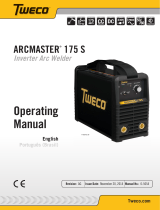 Tweco ARCMASTER 175 S Manuel utilisateur
Tweco ARCMASTER 175 S Manuel utilisateur
-
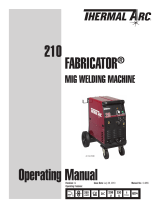 Thermal Arc 210 FABRICATOR® Mig Welding Machine Manuel utilisateur
Thermal Arc 210 FABRICATOR® Mig Welding Machine Manuel utilisateur
-
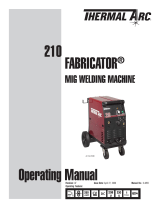 Thermal Arc 210 FABRICATOR® Mig Welding Machine Manuel utilisateur
Thermal Arc 210 FABRICATOR® Mig Welding Machine Manuel utilisateur
-
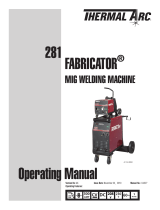 Thermal Arc 281 FABRICATOR® Mig Welding Machine Manuel utilisateur
Thermal Arc 281 FABRICATOR® Mig Welding Machine Manuel utilisateur
-
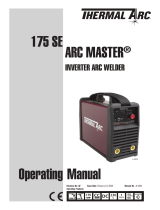 Thermal Arc 175 SE® ARCMASTER Manuel utilisateur
Thermal Arc 175 SE® ARCMASTER Manuel utilisateur
-
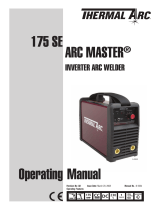 Thermal Arc 175 SE ARC MASTER® Inverter Arc Welder Manuel utilisateur
Thermal Arc 175 SE ARC MASTER® Inverter Arc Welder Manuel utilisateur
-
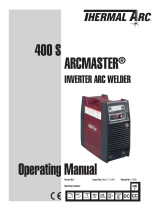 Thermal Arc 400 S ARCMASTER® Inverter Arc Welder Manuel utilisateur
Thermal Arc 400 S ARCMASTER® Inverter Arc Welder Manuel utilisateur
-
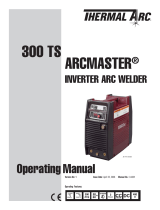 Thermal Arc 300 TS ARCMASTER® Inverter Arc Welder Manuel utilisateur
Thermal Arc 300 TS ARCMASTER® Inverter Arc Welder Manuel utilisateur
-
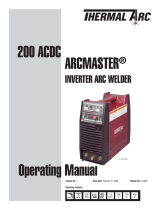 Thermal Arc 200 ACDC ARCMASTER® Inverter Arc Welder Manuel utilisateur
Thermal Arc 200 ACDC ARCMASTER® Inverter Arc Welder Manuel utilisateur
-
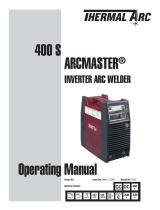 Thermal Arc 400 S ARCMASTER® Inverter Arc Welder Manuel utilisateur
Thermal Arc 400 S ARCMASTER® Inverter Arc Welder Manuel utilisateur
Autres documents
-
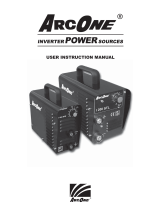 ArcOne Inverter Power Sources Manuel utilisateur
ArcOne Inverter Power Sources Manuel utilisateur
-
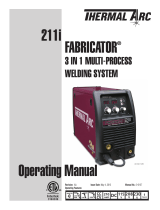 Thermal Arc 211i Mode d'emploi
Thermal Arc 211i Mode d'emploi
-
HobartWelders HELMET INVENTOR AUTO-DARKENING Le manuel du propriétaire
-
PROPOINT 9085986 Le manuel du propriétaire
-
Miller DIGITAL PERFORMANCE SERIES HELMETS Le manuel du propriétaire
-
Ferm WEM1035 Welding Machine Manuel utilisateur
-
Miller DIGITAL INFINITY SERIES AUTO-DARKENING HELMETS CL2 Le manuel du propriétaire
-
Miller DIGITAL ELITE SERIES AUTO-DARKENING HELMETS CL2 Le manuel du propriétaire
-
Miller DIGITAL ELITE SERIES AUTO-DARKENING HELMETS CL2 Le manuel du propriétaire
-
Harris 4403249 Mode d'emploi





































































